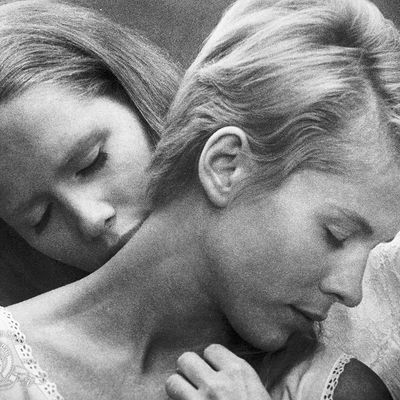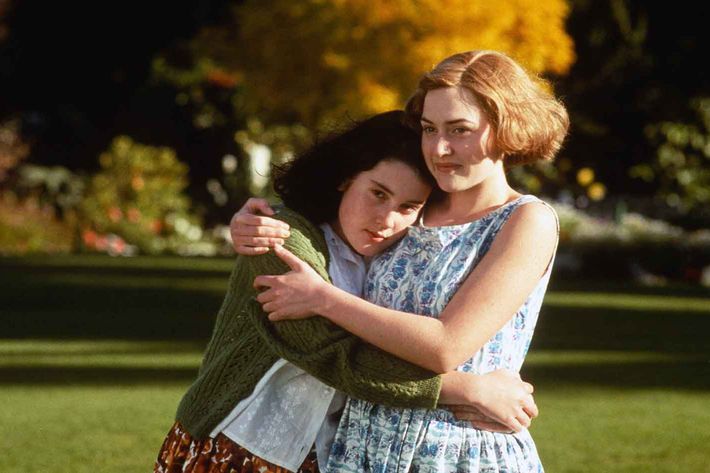
Zombies, vampires, and werewolves come and go, but nothing has troubled filmmakers as enduringly as the mysteries of female bonding. For whatever reason — our inherited medieval imaginations, the cycles of the moon, perhaps — in their short life the movies have been perennially haunted by a fear that when two or more women are left alone together, some kind of dark magic will inevitably rear its head. No wonder the Bechdel test has historically yielded such dismal results. The amount of trouble film still has getting two women to talk to each other about something other than a man belies how redundant so many writers think (subconsciously or otherwise) such a scene might be. After all, what would two women talk about? What would the conflict be, if not about a man? Wouldn’t it get confusing? Wouldn’t it be too hard for the audience to try to tell them apart?
Two women talking: a recipe for witchcraft, an unnatural feedback loop, a cursed redundancy. Ingmar Bergman’s 1966 masterpiece Persona is a landmark for many reasons, but its legacy, which has show no signs of age in the 50 years since it was released in the U.S. and the U.K., is how it stared that anxiety in the face and opened up a loopy, meandering conversation that’s still going on to this day. The nature of that conversation varies depending on who’s talking, but it always comes back to women onscreen — their clashes and merges, and the way they bear the baggage every viewer brings with them to the cinema.
It started from Bergman’s own inability to tell two women apart: After a chance meeting on the street with the film’s eventual stars, Bibi Andersson and Liv Ullmann, Bergman became preoccupied with what he felt was an uncanny resemblance. Search them on Google Image and you will learn, without having watched a frame of Persona, that the mind sees what it wants to see.
There are two contextual details I like about the making of Persona: First, that Bergman had just finished making a parody of Federico Fellini’s 8 ½, (All These Women, 1964, once referred to by Roger Ebert as Bergman’s worst film), another deeply self-aware film about how fucked-up the director’s ideas about women are. The second, that Bergman wrote it during a bout with pneumonia. It was 1965, creatives around the world were discovering the inspirational benefits of mind-altering substances, but few could match the heights Bergman achieved with just a monster dose of fluid in the lungs.
Persona introduces us to two women: Elisabet (Liv Ullmann), a famous stage actress, and Alma (Bibi Andersson), her young nurse. Elisabet is going through some kind of nervous crisis that has rendered her — possibly by choice — mute. Alma is assigned to be her caretaker, and eventually the two move to a summer home by the beach. Elisabet remains silent, while Alma, growing more comfortable with her glamorous companion, provides a running monologue, telling Elisabet of her life — her fiancé, her plans for her future, and eventually, a secret orgy on a beach and her resulting pregnancy and abortion. But Alma’s openness is soon betrayed, and the two become drawn into a kind of dreamy psychological turf war. Their identities begin to overlap — Elisabet’s husband visits and mistakes Alma for his wife; Alma reveals much of Elisabet’s backstory, including the reason behind her apparent loathing of her son. In the end, one woman is left standing, but at that point it’s hard to say which one.
While Persona, with its avant-garde flourishes and violent rending of its own film stock, remains uncategorizable (it gets the agreeably redundant “psychological drama” tag on Wikipedia), its descendants collectively form a kind of loose horror subgenre. Even though they’re largely bloodless, they share a sense of pervasive dread — as well as the double female leads and, more often than not, the remote location. But you can take two women, put them in a cabin by a lake, and make them clash, and all you’ll have is a perfectly conventional domestic drama. What moves Persona and films indebted to it into the realm of horror is the liminal dream-space they wade into, or submerge themselves in completely. Though they start with familiar enough dichotomies — virtuous vs. corrupt, pretty vs. homely, conventional vs. weird, they often end up in a world without binaries, far from any kind of static patriarchal value judgments. Which, depending on who you are, could be the worst nightmare of all.
In going through these “persona swap” films, critic Miriam Bale noted that “one or several of these films is on the list of the favorite films of virtually every woman director or film critic I know.” I can attest to that, and yet I’m struck by how many of these films — and the vast majority of the best of them — are directed and written by men. These films are often excavations of men’s subconscious fears of the slipperiness of identity — the performance of being a woman (hence how many persona-swap heroines are actresses). But they also strike a truthful note for everyone.

My persona-swap list differs slightly from Bale’s; I wouldn’t include Desperately Seeking Susan or Freaky Friday, which aren’t operating in the same (winding, multilane) avenue of inquiry. But I would add to the list Heavenly Creatures, Peter Jackson’s 1994 drama about two adolescent friends who turned to murder in 1950s New Zealand. Although Pauline and Juliet (Melanie Lynskey and Kate Winslet, both making their screen debuts) remain practically distinct as characters, the mania of their friendship, which most women will tell you is only slightly more intense than any other real-life “best friends forever” pairing between teen girls, is what binds them and makes them capable of more. Heavenly Creatures is very nearly a female-empowerment buddy movie; it came out three years after Thelma & Louise and is a kind of inverse of it, with an adolescent intensity that makes its emotional peaks all the more externalized and raw.
Jackson’s co-writer, Fran Walsh, has said she had been interested in the story of the real Parker-Hulme murder since childhood, less for its grisly elements and more for “the uniqueness of the world the two girls had created for themselves.” When complex depictions of female friendship are rare in pop culture, they can double back and become an object of intangible fascination. Like the mind of a killer, a room where two women are alone becomes a kind of cinematic cave fresco, an unknowable, volatile space that may or may not operate within the realm of sanctioned reality. Robert Altman’s 1977 film 3 Women, one of the more acknowledged descendants of Persona, is not only about women who are literal roommates, but women who are both half-human in their own ways. Altman’s film almost operates as a science-fiction story about two artificial intelligences “living” together — running up against each other’s incompleteness and unable to give feedback other than an error message.
Shelley Duvall’s Millie is the most obvious automaton, an image-obsessed casualty of female consumer culture whose efforts to conform have actually led her to ostracize herself. Sissy Spacek’s Pinky is more of a void, an android whose programming was never completed. “Both Pinky and Millie were lost souls trying to find an acceptable way to live,” Altman told David Thompson in the book-length interview Altman on Altman. “Pinky was like an alien who had arrived on the planet and said, ‘how do I hide myself in this world? I’ll become that person.’”
It’s a criticism of a certain kind of anemic idea of womanhood, but it’s not a polemic, even if there are shades of The Stepford Wives in Millie’s “decorated apartment” and horrific dinner-party menu (pigs-in-a-blanket, pudding cups, berry-flavored wine). The idea of 3 Women famously came to Altman in a dream, and like Bergman’s pneumonia haze, the film’s mood and atmosphere is fully formed, while its characters function more as ideas. Both it and Persona speak to a female experience, while never really attempting a literal depiction of it. Both films ask the audience, “You know how women …” then trail off, with an indistinct hand gesture. The audience completes the sentence themselves; therefore it rings true. The women in these films are metaphorical, but their crises are not.

When Persona arrived in the States, in 1967, critics met it with both universal high marks and open bafflement. Susan Sontag, in her famous essay for Sight & Sound, prefaced her critique by remarking at how elusive the film was for criticism: “The most skillful attempt to arrange a single, plausible anecdote out of the film must leave out or contradict some of its key sections, images and procedures.” For the Times, Bosley Crowther suggested that “studious efforts at interpretation” might not be the most rewarding, suggesting the audience rather engage in “outright involvement of themselves, empathically and esthetically, and let the egos and ids fall where they may.”
Very few films can get critics to shut up like this; few have since. It’s interesting to contrast these critical reactions with the popular reception of David Lynch’s Mulholland Drive, probably the most well-known contemporary persona-swap film. Even in 2001, the advent of the internet had changed the way films lived, or snowballed, in the public imagination. It was no longer enough to contemplate two women in a room talking. It was now a thing that had to be solved.
When I moved to Los Angeles in 2003, the Hollywood of Mulholland Drive was what I was after. I was slow to fully appreciate the city, but the first flickers that intoxicated me were the dingy diners and sun-bleached stucco apartments flanked with forlorn topiary shrubs, forgotten bungalows where a dead body might have been festering. There were plenty of Mulholland Drive fan sites on which one could find the addresses of all the film’s locations, but while perusing them I noticed a related, but altogether separate, obsession — decoding the film, as if it was some literal puzzle that would turn into a linear, logical series of events if a viewer devoted enough brain power to the task. I loved Mulholland Drive, but it would have never occurred to me to try to figure it out in any more dedicated way than simply letting the film wash over me again and again, revealing its various dimensions and inflections. (Lynch’s “10 Clues” in the DVD liner notes seemed to me to be a goof, and unrelated to my enjoyment of the film.)
Mulholland Drive defies summary almost as much as Persona, but its inciting events follow Betty (Naomi Watts) an actress who’s just arrived in L.A. and the mysterious, amnesiac Rita (Laura Harring) who shows up at Betty’s apartment after an accident on the titular winding road. Betty decides to help her, eager to get involved in a real Hollywood mystery. But as Betty and Rita get closer to the truth, the film breaks, and another reality emerges. Watts and Harring take on different names and characteristics throughout the film; they become lovers, they become scorned lovers, a third actress throws a wrench into their relationship. Betty goes from being helpless Rita’s would-be savior to a brokenhearted wreck.
To me, the film always seemed to be about the mourning of a bond with another woman, how even in a nonsexual relationship women take on the characteristics and concerns of each other in a way we can’t with men. The mystery of the film could not be put into words, the “solution,” if you needed one, was the climactic visit to Club Silencio, where both women are seemingly inexplicably moved to tears by a lip-sync performance. These are the scenes where Lynch has always excelled, where characters can no longer put what they’re feeling into words. Like Elisabet and Alma and Pinky and Millie, they are metaphors, perhaps even dreams of themselves. But underneath layers of self-mythologizing and a kind of assemblage of personality traits, the struggle, or as the doctor in Persona puts it, “the hopeless dream of being,” is real.

The (male) directors of persona-swap films are often willing to let their (female) stars write their own material. In Persona, Bibi Andersson rewrote much of her infamous beach-foursome monologue (she apparently thought it sounded too much like it was written by a man). In 3 Women Shelley Duvall wrote Millie’s diary entries, using the opportunity to lull herself into her character’s hypnotic banality. These touches proved invaluable to the films. While verisimilitude is not paramount to the success of a persona-swap film, there always comes a beat or two where we need to believe that these women are people. Women writers tend to be able to help with that.
Which is why, with all respect to Bergman, Altman, and Lynch, I’d humbly propose that the persona-swap film be the domain of female filmmakers for the next two decades.
Particularly, I want to see more films as adventurous as Sophia Takal’s 2016 thriller Always Shine. Always Shine is more compact than Persona or Mulholland Drive, more fixated on a single transformative incident. But like Heavenly Creatures, which Fran Walsh helped imbue with an emotionally rich, not-at-all-metaphorical friendship, Always Shine’s centerpiece is the relationship between its leads. It’s not a thought experiment, or some kind of psychoanalytical petri dish; it’s a dinged-up, tangible thing with a complicated history.
There’s not a false note in the script, which again sends its two female leads into the wilderness, to a vacation home in Big Sur. Right away there’s a note in the clash between Anna and Beth (Caitlin FitzGerald and Mackenzie Davis) that we rarely see: overfamiliarity, a kind of dreadful curdling. I’ve never had a conversation that resembled anything between Pinky and Millie, Betty and Rita, or Alma and … Alma. But the tense, deceptively convivial exchanges between Anna and Beth are all too real.
And that’s the thing: Persona-swap films have historically been about men’s anxieties about women left alone, because it was men who were writing and making the movies. In even the most brilliant patriarchal cinema, a scene without a man will never matter as much as a scene with one; a scene without a man isn’t as real as a scene between two women — hence the unreality that so many of these films exist in. Bergman and Altman and Lynch could sense on some level that there was something profound in that unreality, because they were and are great filmmakers. But ask any woman who has been engulfed by an all-consuming relationship with another woman — the swap can be profound while still fully existing in the realm of reality. It doesn’t need to be a dream, or a fevered hallucination. It’s the terrifying magic of two women in a room, talking. And there’s still so much of it we haven’t explored yet.

